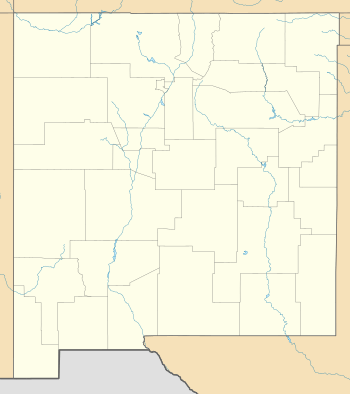Rinconada Formation
The Rinconada Formation is a geologic formation that crops out in the Picuris Mountains of northern New Mexico. Detrital zircon geochronology establishes a minimum age for the Rinconada Formation of about 1723 Mya, placing it in the Statherian period.
| Rinconada Formation Stratigraphic range: Statherian | |
|---|---|
 | |
| Type | Formation |
| Unit of | Hondo Group |
| Underlies | Pilar Formation |
| Overlies | Ortega Formation |
| Thickness | 600 m (2,000 ft) |
| Lithology | |
| Primary | Schist |
| Other | Quartzite |
| Location | |
| Coordinates | 36.2510°N 105.7277°W |
| Region | Picuris Mountains, New Mexico |
| Country | United States |
| Type section | |
| Named for | Village of Rinconada (36°25′43″N 106°07′02″W) |
| Named by | Just |
| Year defined | 1937 |
 Rinconada Formation (the United States)  Rinconada Formation (New Mexico) | |
Description
The formation consists of gray to buff quartz-muscovite schist with some inberbedded quartzite and metaconglomerate.[1] which fills an inverted syncline in the northern Picuris Mountains.[2] It is missing from the Hondo Group in the Tusas Mountains.[3] Detrital zircon geochronology establishes a minimum age for the Rinconada Formation of 1762 Mya. However, this reflects the crystallization age of the source rocks, and the true age is likely closer to 1723 Mya based on zircon ages in the underlying Ortega Formation. This indicates a shift in source region between the Ortega Formation and the Rinconada Formation. [4]
The formation is divided into three informal members.[5] The first is composed of staurolite gneiss and schist, from 60 meters (200 feet) to 150 meters (490 feet) thick, which contains porphyroblasts of garnet and staurolite up to 4 cm long.[1] Most of the staurolite from these beds is twinned, and the large crystals are prized by mineral collectors. Where the schist is heavily micaceous and easily eroded, the ground surface is covered with weathered-out staurolite crystals.[6][5] This member includes spotty basal andalusite-biotite hornfels, from 65 meters (213 feet) to 120 meters (390 feet) thick, consisting of biotite crystals up to 1 centimetre (0.39 inches) in size in a coarsely felted mass of muscovite and quarts. This includes knots of quartz and andalusite up to 25 centimetres (9.8 inches) in diameter.[7]


The staurolite likely crystallized out at a temperature of 532 ± 20 °C and about 3,700 bar total pressure under conditions of water undersaturation.[8]
The second member is a gray-white quartzite, 60 meters (200 feet) to 180 meters (590 feet) thick, with slabby jointing and devoid of sillimanite and kyanite.[9] The third member is a muscovite-rich phyllite with a pearly to greenish gray sheen containing small staurolite and garnet crystals.[10]
The Rinconada Formation is separated from the overlying Pilar Formation by an unconformity representing a gap in geologic time of 200 million years.[4]
The Rinconada Formation is interpreted as deltaic, fluvial, and shallow marine deposition of the regressive sequence of a marine transgression. This was likely part of the northern coast of a back-arc basin associated with the Yavapai orogeny, named the Pilar basin. The quartzite at the upper contact with the Pilar Formation then represents renewed transgression.[4]
History of investigation
The beds making up the unit were originally assigned to the Ortega quartzite by Evan Just during his 1937 survey of pegmatites in northern New Mexico. Evan gave the informal name, Rincada schist, to these beds and noted the presence of staurolite [[porphyroblasts[[.[11] Montgomery formalized the designation of the mixed schist and quartzite beds as the Rinconada member of the Ortega Formation in 1953.[12] The Rinconada Member was promoted to independent formation status by Bauer and Williams in their sweeping revision of the Precambrian stratigraphy of northern New Mexico in 1987.[3]
Footnotes
- Just 1937, p.22
- Bauer 2004, p.200
- Bauer and Williams 1989, p.50
- Jones et al. 2011
- Miller et al. 1963, p.11
- Montgomery 1953, pp.13-14
- Montgomery 1953, pp.12-13
- Holdaway 1978
- Montgomery 1953, p.14
- Montgomery 1953, p.15
- Just 1937, p.21
- Montgomery 1953, p.12
References
- Barrett, Michael E.; Kirschner, Carolyn E. (1979). "Depositional systems in the Rinconada Formation (Precambrian), Taos County, New Mexico" (PDF). New Mexico Geological Society Field Conference Series. 30: 121. Retrieved 17 April 2020.
- Bauer, Paul W. (2004). "Proterozoic rocks of the Pilar Cliffs, Picuris Mountains, New Mexico" (PDF). New Mexico Geological Society Field Conference Series. 55: 193–205. Retrieved 15 April 2020.
- Bauer, Paul W.; Williams, Michael L. (August 1989). "Stratigraphic nomenclature ol proterozoic rocks, northern New Mexico-revisions, redefinitions, and formaliza" (PDF). New Mexico Geology. 11 (3). Retrieved 15 April 2020.
- Holdaway, M.J. (1978). "Significance of chloritoid-bearing and staurolite-bearing rocks in the Picuris Range, New Mexico". GSA Bulletin. 89 (9): 1404-1414. Retrieved 17 April 2020.
- Just, Evan (1937). "Geology and Economic Features of the Pegmatites of Taos and Rio Arriba Counties, New Mexico" (PDF). New Mexico School of Mines Bulletin (13).
- Jones, James V., III; Daniel, Christopher G.; Frei, Dirk; Thrane, Kristine (2011). "Revised regional correlations and tectonic implications of Paleoproterozoic and Mesoproterozoic metasedimentary rocks in northern New Mexico, USA: New findings from detrital zircon studies of the Hondo Group, Vadito Group, and Marqueñas Formation". Geosphere. 7 (4): 974–991. doi:10.1130/GES00614.1. Retrieved 15 April 2020.
- Miller, J.P.; Montgomery, Arthur; Sutherland, P.K. (1963). "Geology of part of the southern Sangre de Cristo Mountains, New Mexico" (PDF). New Mexico Bureau of Mines and Mineral Resources Memoir. 11: 7–21. Retrieved 9 May 2020.
- Montgomery, Arthur (1953). "PreCambrian Geology of the Picuris Range, northcentral New Mexico" (PDF). State Bureau of Minfluvial to shallow-marine deposition on a southward-deepening siliciclastic shelf.es and Mineral Resources Bulletins. 30.